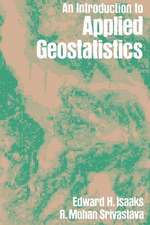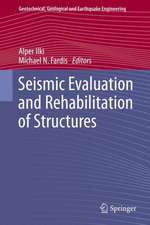Geostatistics Oslo 2012: Quantitative Geology and Geostatistics, cartea 17
Editat de Petter Abrahamsen, Ragnar Hauge, Odd Kolbjørnsenen Limba Engleză Paperback – 11 iun 2014
Geostatistics is vital to any industry dependent on natural resources. Methods from geostatistics are used for estimating reserves, quantifying economical risk and planning of future industrial operations. Geostatistics is also an important tool for mapping environmental hazard and integrating climate data.
| Toate formatele și edițiile | Preț | Express |
|---|---|---|
| Paperback (1) | 957.62 lei 6-8 săpt. | |
| SPRINGER NETHERLANDS – 11 iun 2014 | 957.62 lei 6-8 săpt. | |
| Hardback (1) | 962.66 lei 6-8 săpt. | |
| SPRINGER NETHERLANDS – 9 mai 2012 | 962.66 lei 6-8 săpt. |
Din seria Quantitative Geology and Geostatistics
- 18%
 Preț: 1237.93 lei
Preț: 1237.93 lei - 18%
 Preț: 1236.82 lei
Preț: 1236.82 lei - 18%
 Preț: 1235.43 lei
Preț: 1235.43 lei - 18%
 Preț: 950.96 lei
Preț: 950.96 lei - 18%
 Preț: 1241.10 lei
Preț: 1241.10 lei - 24%
 Preț: 1148.01 lei
Preț: 1148.01 lei - 15%
 Preț: 661.32 lei
Preț: 661.32 lei - 18%
 Preț: 951.29 lei
Preț: 951.29 lei - 18%
 Preț: 1018.37 lei
Preț: 1018.37 lei - 24%
 Preț: 1047.49 lei
Preț: 1047.49 lei - 15%
 Preț: 644.82 lei
Preț: 644.82 lei - 5%
 Preț: 649.68 lei
Preț: 649.68 lei - 24%
 Preț: 1133.44 lei
Preț: 1133.44 lei - 20%
 Preț: 662.18 lei
Preț: 662.18 lei - 18%
 Preț: 1234.00 lei
Preț: 1234.00 lei - 15%
 Preț: 645.60 lei
Preț: 645.60 lei - 15%
 Preț: 602.89 lei
Preț: 602.89 lei - 18%
 Preț: 1835.21 lei
Preț: 1835.21 lei - 18%
 Preț: 1233.52 lei
Preț: 1233.52 lei
Preț: 957.62 lei
Preț vechi: 1167.83 lei
-18% Nou
Puncte Express: 1436
Preț estimativ în valută:
183.24€ • 191.71$ • 152.22£
183.24€ • 191.71$ • 152.22£
Carte tipărită la comandă
Livrare economică 02-16 aprilie
Preluare comenzi: 021 569.72.76
Specificații
ISBN-13: 9789400795969
ISBN-10: 9400795963
Pagini: 576
Ilustrații: XIV, 559 p.
Dimensiuni: 155 x 235 x 30 mm
Greutate: 0.79 kg
Ediția:2012
Editura: SPRINGER NETHERLANDS
Colecția Springer
Seria Quantitative Geology and Geostatistics
Locul publicării:Dordrecht, Netherlands
ISBN-10: 9400795963
Pagini: 576
Ilustrații: XIV, 559 p.
Dimensiuni: 155 x 235 x 30 mm
Greutate: 0.79 kg
Ediția:2012
Editura: SPRINGER NETHERLANDS
Colecția Springer
Seria Quantitative Geology and Geostatistics
Locul publicării:Dordrecht, Netherlands
Public țintă
ResearchCuprins
Foreword.- Preface.- Acknowledgements.- Part I Theory.- Sequential simulation with iterative methods .- Applications of randomized methods for decomposing and simulating from large covariance matrices.- Event-based geostatistical modeling: description and applications.- A plurigaussian model for simulating regionalized compositions.- New flexible non-parametric data transformation for trans-Gaussian kriging .- Revisiting the linear model of coregionalisation.- Modeling nonlinear beta probability fields.- Approximations of high-order spatial statistics through decomposition.- Multiple-point geostatistical simulation based on genetic algorithms implemented in a shared-memory supercomputer.- The edge effect in geostatistical simulations.- Extensions of the parametric inference of spatial covariances by maximum likelihood.- Part II Petroleum.- Constraining a heavy oil reservoir to temperature and time lapse seismic data using the EnKF.- Micro-modeling for enhanced small scale porosity-permeability relationships.- Applications of data coherency for data analysis and geological zonation .- Multiscale modeling of fracture network in a carbonate reservoir.- Uncertainty quantification and feedback control using a model selection approach applied to a polymer flooding process.- Efficient conditional simulation of spatial patterns using a pattern-growth algorithm.- Multiple-point statistics in a non-gridded domain: application to karst/fracture network modeling.- Sequential simulations of mixed discrete-continuous properties: sequential Gaussian mixture simulation.- Accounting for seismic trends in stochastic well correlation.- Some newer algorithms in joint categorical and continuous inversion problems around seismic data.- Non-random discrete fracture network modelling.- Part III Mining.- Kriging and simulation in presence of stationary domains:.- Developments in boundary modeling.- Assessing uncertainty in recovery functions: a practical approach.- Comparative study of localized block simulations and localized uniform conditioning in the multivariate case.- Application of stochastic simulations and quantifying uncertainties in the drilling of roll front uranium deposits.- Multivariate estimation using log ratios: a worked alternative.- Measuring the impact of the change of support and information effect at olympic dam.- Comparative study of two gaussian simulation algorithms, Boddington gold deposit .- Non-multi-gaussian multivariate simulations with guaranteed reproduction of inter-variable correlations.- Field parametric geostatistics—a rigorous theory to solve problems of highly skewed distributions.- Multiple-point geostatistics for modeling lithological domains at a Brazilian iron ore deposit using the single normal equations simulation algorithm.- Practical implementation of non-linear transforms for modeling geometallurgical variables.- Combined use of lithological and grade simulations for risk analysis in iron ore, Brazil.- The use of geostatistical simulation to optimize the homogenization and blending strategies.- Plurigaussian simulations used to analyze the uncertainty in resources estimation from a lateritic nickel deposit.- Domaining by clustering multivariate geostatistical data.- The influence of geostatistical techniques on geological uncertainty .- Part IV Environmental, climate and hydrology.- A study on how top-surface morphology influences the storage capacity of CO2 in saline aquifers.- Modeling and analysis of daily rainfall data.- A stochastic model in space and time for monthly maximum significant wave height.- Interpolation of concentration measurements by kriging using flow coordinates.- A comparison of methods for solving the sensor location problem.- Comparing geostatistical models for river networks.- Author index.- Subject index.
Textul de pe ultima copertă
This book consists of 44 technical papers presented at the Ninth International Geostatistics Congress held in Oslo, Norway in June 2012. The papers have been reviewed by a panel of specialists in Geostatistics. The book is divided into four main sections: Theory; Petroleum; Mining; and Environment, Climate and Hydrology. The first section focuses on new ideas of general interest to many fields of applications. The next sections are more focused on the particular needs of the particular industry or activity.
Geostatistics is vital to any industry dependent on natural resources. Methods from geostatistics are used for estimating reserves, quantifying economical risk and planning of future industrial operations. Geostatistics is also an important tool for mapping environmental hazard and integrating climate data.
Geostatistics is vital to any industry dependent on natural resources. Methods from geostatistics are used for estimating reserves, quantifying economical risk and planning of future industrial operations. Geostatistics is also an important tool for mapping environmental hazard and integrating climate data.
Caracteristici
Collection of state-of-the-art scientific work within Geostatistics Contains new and innovative ideas in theoretical developments of Geostatistics A broad selection of novel geostatistical methods applied to various problems Includes supplementary material: sn.pub/extras












